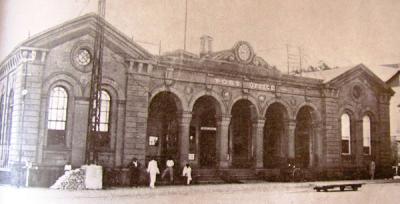In February 2012, the Mauritius Post Limited commemorated the 240th anniversary of the establishment of the postal system in Mauritius. This year also marks the 142nd anniversary of the inauguration of the General Post Office building, located near Port Louis harbour, and the 54th anniversary of it being decreed national monument.
For almost one and a half centuries, this imposing historic structure has served as the main post office of Mauritius and for more than a century, as the office of the Postmaster-General. Therefore, it has played a key role in the development and expansion of the postal service in Mauritius ever since the late 19th century.
A Rare National Monument
The General Post Office was decreed a national monument in 1958 through Government Notice No.614 by Governor Sir Robert Scott, based upon the recommendation of the Ancient Monuments Board. Almost three decades later, it was reconfirmed as a national monument through the National Monuments Act of 1985. More recently, the General Post Office was listed on the “National Monuments of Mauritius” which is a schedule attached to the National Heritage Fund Act (No.40) of 2003. Today, it is considered to be one of the most important national heritage in the Aapravasi Ghat World Heritage Buffer Zone and the city of Port Louis.
The General Post Office, or often referred to as “la post centrale” by Mauritians, consists of large stone blocks as well as of thick iron and wooden beams which are embedded in the structure. The front part of the building has five arches and the words “Post Office” are written in the Oxford style. The inscription of the date ‘1868 A.D’ is also clearly seen. Between 1847 and 1870, the postal headquarters of British Mauritius was known as the Postmaster Building and it was located in central Port Louis. In 1853, Reverend Patrick Beaton, a British missionary and visitor, mentioned that the old Postmaster Building was situated on Government Street near to Government House.
A Historical Aspect
The General Post Office was constructed between 1865 and 1870 and was inaugurated in December 1870 and certainly not in 1868. The erection of this national heritage started in January 1865 under the supervision of Surveyor General Morrison. Around two years later, in January 1867, shortly after his arrival in Mauritius, Nicholas Pike, an American Consul and visitor, observed: “There is a new post office in the course of erection near the Customs House. It is to be hoped that the new light and airy place will give a proportionate impetus to the activity of the clerks on mail day.”
By December 1868, more than seventy-five percent of the building was completed. Between 1869 and December 1870, the roof, the exterior walls and the front part of the edifice were finished. The General Post Office of Mauritius was built at a cost of between 10,000 and 11,000 pounds sterling.
It should be noted that over a period of six years, the Surveyor General’s Office used more than 80 workers for the construction of this particular structure. The overwhelming majority of these workers were Indian and non-Indian vagrants who were incarcerated at the Vagrant Depot of Grand River North West and prisoners from the Port Louis Prisons.
At the same time, a few of them were also ex-indentured workers, Indo-Mauritians and Creoles (mostly descendants of slaves and apprentices) who were engaged on monthly contracts. They were skilled craftsmen such as stone sculptors/stone cutters, carpenters, masons, and blacksmiths who earned high wages for their work. It is evident that these skilled and unskilled workers who, by the sweat of their brows, were the true builders of the General Post Office.
The Colonial Postal System
In December 1870, the General Post Office was officially inaugurated and became functional on 21st December of the same year. In October 1876, postal stamps were also being printed and issued there by trained postal workers. A few months later, in April 1877, the Central Telegraph Office became fully operational at the General Post Office.
The General Post Office of Mauritius was modeled on public buildings which were being erected during the same period in Great Britain. In addition, it is an excellent example of traditional colonial architecture of the mid-Victorian Era which can still be seen in other former British colonies such as India, Sri Lanka, South Africa, Trinidad, and Guyana.
During the early 1870s, it was at the General Post Office that the establishment of the rural post offices was planned and implemented by the Postmaster General and his staff. During the 1870s and 1880s, around 33 post offices were set up in the eight rural districts of the island. Thus, the General Post Office building played a central role in the creation of a modern colonial postal system in Mauritius. It is also important to highlight that during this period, there were few British and European colonies which had such a well-organized and efficient local postal service.
The Heritage Aspect
The General Post Office is an important structure in terms of architectural evolution of colonial buildings during the nineteenth century in Mauritius. The design of the roof, the clock and the exterior design, especially the five arches as well as the inscriptions, on the front part of this structure are important examples of the sophisticated craftsmanship which developed in British Mauritius during the mid-Victorian Era.
There are other important post offices which share a similar history with the General Post Office such as the Rose Hill Post Office and the old Souillac Post Office which were built more than a century ago through the labour of Mauritian workers. It is a tangible symbol of our Mauritian architectural and cultural heritage. Lastly, the establishment of the Postal Museum in the General Post Office building in 2008 further enhances its historic and heritage value which should be preserved for future generations.
OUR MAURITIAN NATIONAL HERITAGE: The Historical & Heritage Value of the General Post Office of Mauritius
- Publicité -
EN CONTINU ↻


